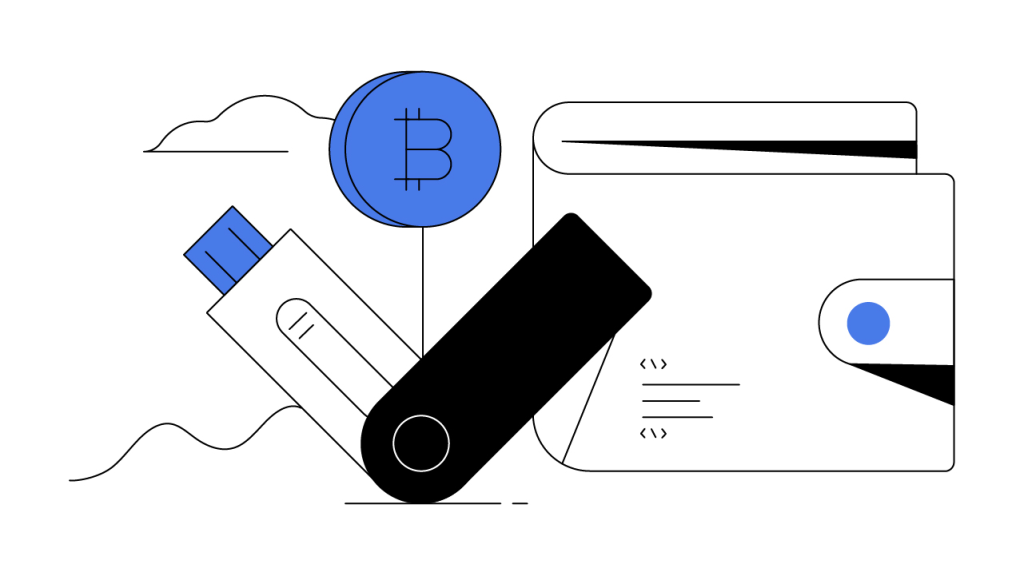Contents
Hardware Wallets: What You Need to Know
Hardware wallets are the gold standard for secure, offline, non-custodial crypto storage. However, they require responsibility and have some trade-offs.

Summary
Crypto hardware wallets are the most secure non-custodial way to store your digital assets, providing you with control of your private keys and by extension, your cryptocurrency. These crypto wallets typically look like a USB storage device with a screen and analog buttons. Hardware wallets store funds and sign crypto transactions offline, making them virtually immune to online hacking attempts. While they have always been very secure, recent advances have made them more user-friendly. You may want to consider this kind of wallet if you hold significant amounts of crypto.
Non-Custodial and Cold Wallets
With a crypto hardware wallet, you do not need to trust a third party: You have complete control over your funds. However, individual control over your crypto funds requires an equal measure of personal responsibility. Hardware wallets are the most secure , but all versions require more caution and care than , where an exchange holds your funds for you.
The design of hardware wallets gives them unmatched security. Stealing crypto from a hardware wallet would require either physical possession of the hardware wallet and your PIN, or your . Turned off while not in use, hardware wallets are connected to a computer or phone via a USB port or Bluetooth to transact. The “signing” of transactions is done “in-device,” before being broadcast to a via the internet-connected device. It is therefore still considered an , even while transacting. This design feature makes it impossible to hack remotely; even the most powerful can’t “sign” a hardware wallet transaction to steal crypto funds.
Crypto Hardware Wallet Advances
Initially used for long-term storage of significant amounts of crypto, hardware wallets weren’t nearly as user-friendly as — and could cost up to $200 USD. But, they have since come a long way in terms of user experience and most major hardware wallets can now integrate with desktop or mobile apps as well as other wallets. These integrations give you a better interface that’s easier to use, without sacrificing a hardware wallet’s security. Many of these apps also allow you to trade while keeping custody of your .
Do You Trust Yourself?
Although non-custodial wallets don’t require third party trust, you must be ready to trust yourself. If your wallet is inaccessible or damaged; or if your password is forgotten, you could lose access to your funds completely. Non-custodial wallets with significant funds should be protected with a PIN. Make sure to store your PIN securely offline in written form, keep it a secret, and don’t give anyone physical access to your hardware wallet.
Like your cash wallet, you should do your best to protect your hardware crypto wallet from physical theft. However, should anyone gain physical access to it, they still would not have access to your funds without the PIN. PIN-protected, your funds wouldn’t be accessible to the thief and you would be able to regenerate your hardware wallet’s holdings on another hardware device with a recovery phrase.
Recovery Phrase
Should your device become inaccessible or non-functional, you can use your recovery phrase to regenerate the cryptocurrency held in your hardware wallet.
As with your PIN, you should keep your recovery phrase a secret, stored securely in an offline environment. In many ways, securing your recovery phrase is more important than safeguarding your PIN. While you’ll need your PIN to use your hardware wallet, merely possessing your recovery phrase would be enough to regenerate your wallet elsewhere and gain access to your funds. Conversely, your PIN would be useless without the corresponding hardware device.
You should copy your recovery phrase secretly and neatly several times with a pen and paper. Laminating the copies is recommended, provided you do it yourself, and in private. Many go beyond this and buy a steel recovery-phrase kit, which lets you stamp your recovery phrase in steel. It’s a small price to pay to prevent your recovery phrase from falling victim to water or fire damage. Please keep in mind that while storing more copies of your recovery phrase reduces the chance of loss, it also increases the chance that someone could find it.
Keep Your Funds Safe With a Crypto Hardware Wallet
Hardware wallets are, at time of writing, the only recommended form of non-custodial cold storage, where there is no intermediary between you and your cryptocurrency funds. If you want the most secure and trusted way to store funds, use an established hardware wallet. Be sure to secretly store your PIN and recovery phrase physically and offline. Forgetting your PIN and recovery phrase would mean that your funds are trapped inside your wallet — forever. A hardware wallet is especially secure, provided you can trust yourself to safely store it and the associated PIN and recovery phrase.

Author
Is this article helpful?
